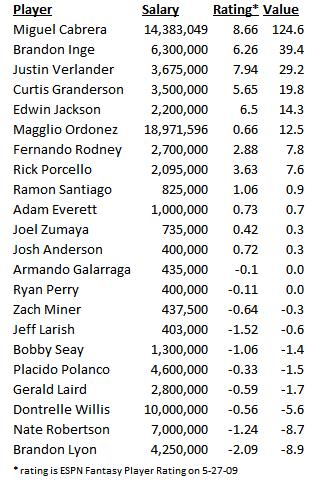Now that we are a quarter of the way through the season, I thought it would be fun to take a second and evaluate the Tigers old and new against their free-agent winter prospects. I’m using the 2009 salaries provided by ESPN.com and for a quantitative look at productivity, the ESPN Fantasy Player Rating. Admittedly this is not the most scientific study, but it does provide two comparative data points with which to evaluate Mr. D’s spending habits. (And let’s not forget, we are still in first place.)
Dollar value is calculated by multiplying the players 2009 salary by his current player rating (as of 5-27-09) and then dividing by 100,000 to get a usable number.
On first review, the Tigs fall right where you think they should. Namely, Cabrera is worth every penny, Inge and Curt need raises, and Nate Robertson and Brandon Lyon are thieving bums.
Look a little closer though and you’ll argue that Dontrelle hasn’t had enough data points this year to accrue a valid rating, making his value an outlier. I would argue that the guy makes $10 Million a year and that the evaluation is accurate.
Everette and Santiago are, as expected, in the middle of the pack and well worth the cost. Josh Anderson has been a nice surprise with a league-minimum salary yet a positive player rating, while Gerald Laird is worth so much more than he’s given credit for here in unmeasureables.
So anyway, nothing too spectacular here as far as shocking information, but it appears that this confirms Dave Dombrowski as a man that knows how to spend a dollar wisely (for the most part cough… Gary Sheff… cough).

May 29, 2009 at 4:34 pm |
Yeah, no, except this is insane.
First off, the ESPN fantasy data is bad to use—it includes stuff like RBI, which have no predictive ability. You want something like the WARP rating from Baseball Prospectus. Second, you don’t want to multiply, you want to divide, since “value” is the ratio of money spent to wins provided. Otherwise, you end up with crazy results like the ones on the table there, with Magglio’s high salary offsetting his relatively low rating.
Bad math, dude, bad math.
May 31, 2009 at 4:08 am |
I believe the problem lies in a broken kanuter valve, remember x plus y does not always = Q.
June 1, 2009 at 7:57 am |
Agree with js — you want to divide, not multiply. You need to divide each player’s salary by a statistic which measures productivity… Maybe VORP (Value over replacement player)?
What you have is not so good. It says if two players have the same stats, the higher-paid player has more “value” which is exactly backwards.
June 1, 2009 at 10:30 am |
I should have qualified this by saying it isn’t scientific. Apologies.